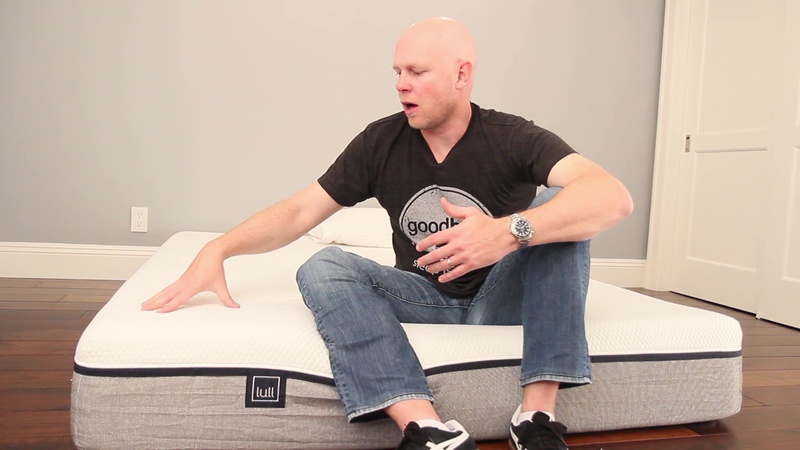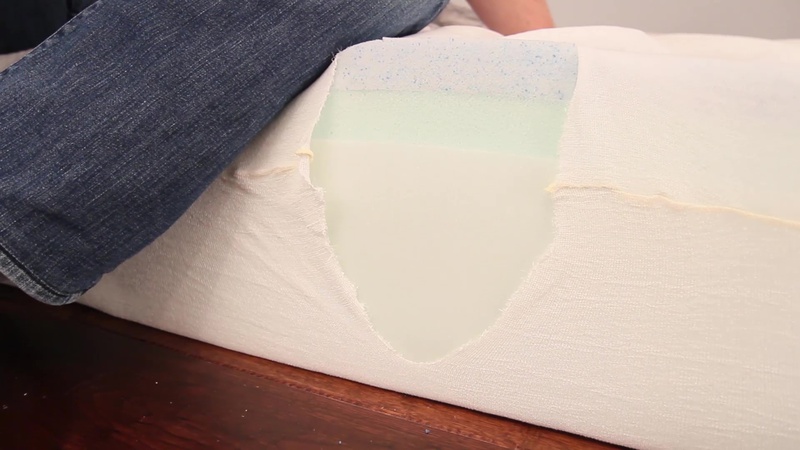Cover
The three layers of the Lull mattress are wrapped in a very sturdy feeling knit cover. It's quite stretchy and is flat and not cushioned/quilted. We tugged and pulled at the cover and found it to be well constructed, with a nice soft feel.

Comfort & Feel
There are three aspects that make up our assessment of comfort and feel. We call these "preference-based characteristics" because no rating here is better or worse – rather, the attributes that are most desirable to you will be determined solely by your personal preferences. We apply the same classification standards to each mattress so you can more easily compare apples to apples.
Softness ( what’s this )
Keep in mind that what mattress companies call “firm” or “soft” is a purely a preference. All mattresses should be supportive and promote healthy spinal alignment. Whether a mattress is fluffy and squishy (what mattress companies call soft or plush), or less so (what companies call firm), is purely down to your personal needs and preferences.
We classify the Lull mattress as a Medium in terms of softness overall, right in the middle in terms of softness.
Not sure what softness is best for you? Take our Mattress Match Quiz and find out.
| Softness Level (1=Least Soft, 9=Most Soft) |
5 | Medium |
Cushioning Depth ( what’s this )
This refers to how deeply you sink into the mattress or feel cradled or hugged, versus a feeling of floating on top of the bed. We found the Lull Essential again to be a middle-of-the-road mattress between the two poles, right between that hugged/deep sinking feeling versus a firmer floating on top feeling.
| Cushioning Depth (1=Shallowest, 9=Deepest) |
5 | Medium cushioning |

Responsiveness ( what’s this )
Responsiveness refers to how quickly a mattress recovers its shape after being compressed. When you press your hand into the mattress, for instance, then remove it, does it take several seconds for the mattress to return to flat, or does it recover immediately?
While the Lull mattress does have a small 1.5” layer of memory foam as the top layer, it really does not have any of that recognizable memory-foam feel, where after compressed, your hand print takes several seconds to disappear (some describe this as a slow, melting into the mattress feeling).
Rather, the Lull bed is fairly quick responding, meaning it recovers its shape quickly; perhaps not as quickly as an innerspring mattress might do, but definitely a lot faster than what you’d associate with memory foam.
This also translates to bounce, which we test in two ways. When we dropped our 16-lb. bowling ball in the mattress, it bounced only once, and when our tester dropped his weight onto the bed, he did not bounce at all. This mattress has practically no bounce at all, which comes into play when we discuss motion isolation further below.
| Memory Feel (1=Least, 9=Most) |
3 | Not much |
| Bounce (1=Least, 9=Most) |
2 | Almost none |
Back Support & Pressure Relief
The two things that you should always be sure to get from your mattress are spinal alignment (commonly thought of as "back support") and pressure relief. Unfortunately, no mattress will deliver these two things equally well for all sleepers. In particular, spinal alignment and pressure relief capabilities will vary across sleepers with different weights, body shapes, and sleep positions. To help you determine how this mattress will perform for you, we break down our spinal alignment and pressure relief assessments by sleeper type.
In our evaluations, the Lull mattresses afforded very good support for back sleepers, and would be suitable for a broad range and sizes of people.
The Lull bed was also good in our view for stomach sleepers with the possible exception of those heavier than about 200 pounds, where we questioned whether hips might sink into the mattress’s soft top layers too deeply, bottoming out on the firmer support layer.
We also thought the Lull bed would be a good choice for most side sleepers, again excepting those on the higher end of the weight scale.
Spinal Alignment
The key to good back support is maintaining proper spinal alignment while you sleep. This means that the mattress should hold your spine in roughly the same position it's in when you're standing. The ability of a given mattress to do this will generally depend on your weight, sleep position, and body shape.
Here is how we break down the spinal alignment of the Lull mattress:
| Weight | Range | Back Sleepers | Side Sleepers | Stomach Sleepers |
| Lighter | <150 lb | 9 | 7 | 9 |
| Average | 150 to 200 lb | 9 | 7 | 8 |
| Above Average | 200 to 250 lb | 9 | 7 | 7 |
| Heavier | >250 lb | 9 | 6 | 6 |
Back Sleepers:
While our tester was on his back, he noted that his hips sank just deeply enough to create a perfectly neutral spine, while he felt the mattress did a nice job reaching up to support his lumbar curve. We feel that sleepers of a wide weight range would have a similar experience in this position on the Lull mattress.
Side Sleepers:
Side sleeping was also good for our tester. Shoulders could have sunk a bit more into the mattress, but it wasn't bothersome, and overall spinal alignment was good. We did question whether those much heavier than our tester would "bottom out" and sink through the two softer layers of foam, finding themselves resting on the firm support layer.Stomach Sleepers:
Achieving good spinal alignment for stomach sleepers can often be trickier as the hips can tend to sink down too far with some mattresses, but our tester felt well supported in this position as well. We did question whether those over 200 lbs. would experience the same support, and suspect that hips might sink far enough to create less than ideal spinal alignment. But for lighter people who sleep on their stomachs, we felt the Lull mattress would be a good match.
Pressure Relief
When a mattress pushes back against your body with too much force in a concentrated area, the result can be pain, soreness, loss of circulation, excessive tossing, and other problems. In general, such "pressure points" are of greatest concern for side sleepers, since that's the position in which your body's weight is distributed over the smallest surface area. To find the right mattress for your needs, keep in mind that the pressure-relieving capabilities of any given mattress will vary depending on the sleeper. Factors like your weight and body shape (e.g., broader shoulders and/or hips) will determine how far you sink into the mattress, and the pressure relief offered by that mattress will vary widely at different depths.
Here's how we sized up the pressure relief of the Lull mattress:
| Weight | Range | Typical Curves | Extra Curvy |
| Lighter | <150 lb | 7 | 7 |
| Average | 150 to 200 lb | 7 | 7 |
| Above Average | 200 to 250 lb | 7 | 7 |
| Heavier | >250 lb | 6 | 6 |
Overall, we found the pressure relief offered by the Lull mattress to be good. Our tester didn’t experience any specific issues, and we thought that the 1.5-inch memory foam layer was playing a positive role. Again, we questioned whether heavier individuals would sink through the soft foam layers and find themselves resting on the harder support layer. The same goes for people who are broad-shouldered or broad-hipped.

Other Features
Beyond the preference-based characteristics of comfort and feel, and the body matching for spinal alignment and pressure relief, a mattress will have a number of other attributes that can make it a better or worse choice for you. We call these "priority-based characteristics" because they are areas in which a mattress can be better or worse, but that will have differing amounts of importance to each sleeper. So, determining how much importance to give to these features will be entirely a matter of your own personal priorities. As always, we apply the same ratings standards to each mattress so you can more easily compare apples to apples.
Motion Isolation ( what’s this )
With a bowling pin standing upright on the Lull bed, we tested motion isolation by dropping a 16-lb. bowling ball on it, as well as the whole weight of our 200-lb. tester.
In both tests, the pin didn't move. For that reason, we felt that the Lull mattress would be an excellent choice for couples who don’t want to feel their partner getting in and out of bed.
| Motion Isolation Rating |
10 /10 | Exceptional |
Temperature ( what’s this )
If you tend to overheat in bed, foam mattresses in general are unlikely to be the ideal choice since blocks of foam don't typically allow for optimal airflow. In that case, an innerspring or hybrid (innerspring plus foam) bed may be a better choice overall.
Because you don't sink too deeply into the Lull mattress, more of your body is exposed to the air, an aspect that will help with heat dissipation. The top layer of memory foam is infused with gel, and gel is a conductor, so that might help the mattress feel a bit cooler as well.
If overheating in bed is an issue for you, and you’ve experienced it with other mattresses, other models have features that are specifically intended to address this, and an all-foam mattress may not be the best choice.
| Stays 'Cool' Rating |
5 /10 | Okay |
Edge Support ( what’s this )
Foam mattresses aren’t typically very supportive along the very edge of the mattress—important if you like to sit on the edge of the bed, or if you tend to sleep along the edge. But we found the Lull mattress to be better than competing budget all-foam beds.
When laying on the very edge of the mattress, our tester felt stable, and did not feel that he was sliding off to an excessive degree.
| Edge Support Rating |
7 /10 |
Good |

Ease of Repositioning ( what’s this )
If you tend to move and change positions a lot over the course of a night, ease of repositioning will be a priority for you. Our tester did experience any problems at all with moving around or rolling into a different position on the Lull bed.
| Repositioning Rating |
9 /10 | Excellent |
Green Features ( what’s this )
For mattress shoppers concerned with the use of natural materials, sustainable manufacturing practices or the like, we offer our subjective evaluation of any efforts taken by the company to make the mattress more green, healthy, or safe.
In the case of the Lull mattress, the company makes no claims about the use of natural materials. It's foams are petroleum-based, glued together with chemical adhesives.
The company tells us its mattresses are made in the United States and China, indicated on the specific mattress's label. So there's no way to know when ordering where your mattress has been made. We always have concerns with mattresses shipped from countries like China, which have looser restrictions on manufacturing practices and fair-wage labor.
Lull does say that the foams they use are certified to the CertiPUR-US standard, which verifies that a material has low VOC off-gassing as well as a lack of chemicals and other substances regulated by the CPSC. The fire sock and cover are certified to the OEKO-TEX standard, which asserts similar minimal off-gassing.
| Green Rating |
4 /10 | Fair |
Adjustable Base Compatibility ( what’s this )
We did not specifically test the Lull mattress on an adjustable bed frame. However, the company says that using the bed on an adjustable frame is just fine; it will not damage the mattress or void your warranty assuming the frame is properly supportive. And based on our experience with similarly constructed mattresses, we might expect a little lifting at the foot, or some mild bunching of the quilt.
| Adjustable Base Use Rating |
8 /10 | Very good |
Price, Value & Longevity
How Much Does a Lull Mattress Cost?
Prices shown are list prices. Remember that GoodBed keeps our site current with the best available discounts on all online mattresses, many of which are exclusive discounts for our readers.
What Are You Getting?
The Lull bed is a 10-inch mattress made of polyurethane foam along with a 1.5” layer of gel memory foam as the top layer. It includes a sturdy, yet soft and stretchy cover that stood up to our pulling and tugging. The mattress comes with a 100-night trial period with a full refund and pickup of the mattress should you decide to return it.
How Long Will the Lull Mattress Last?
When it comes to estimating the comfort lifespan of a mattress, we tend to use foam density as our best, albeit imperfect, predictor of how long a foam will retain its shape and resiliency. However, Lull does not disclose the densities of the foam used in this bed. So we can't hazard a guess as to how long this mattress might last. It does come with a 10-year warranty, which should give some assurance.
Overall Value
The Lull mattress is competing in a crowded field, with a number of other all-foam mattresses in the same prices range, and offering a similar trial period and return policy. The Lull bed is a 10-inch mattress; some similar beds in this price range measure around 8.5 inches.
In our evaluations, the Lull mattress proved itself a good performer all around. Motion isolation, edge support, back support, and ease of movement were all just fine on this bed, and we think it will suit a wide variety of individuals in a range of sleeping positions. For that reason, it could be a good choice for couples who sleep in different positions, and it's a particularly good choice, in our view, for those sensitive to being disturbed by a partner's movements.
Taking all that together, from a performance standpoint, we’ve reviewed other beds that in our view were better for certain types of sleeping, had better pressure relief, had more plush covers, better edge support, etc. And some of those mattresses cost just a couple of hundred dollars more than the Lull mattress yet offer measurably better features. Even so, for a wide range of people of average size, the Lull bed is a low-hassle, basic mattress that comes with a solid 100-night trial period and 10-year warranty.
| Value Rating |
6 /10 | Pretty good |









































 Comparison
Comparison






